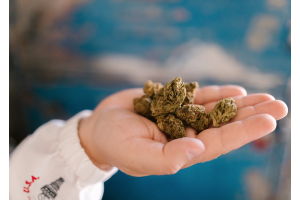The Rise of Synthetic Cannabis

The year of the synthetic cannabinoid. This year has seen exponential growth in interest around these new, novel, and potentially therapeutic or lethal man-made cannabis mimicking compounds.
Before we go any further into this discussion, we must first define exactly what is meant by the term ‘synthetic cannabinoid.’ Unfortunately, there is currently no real consensus on what exactly the term ‘synthetic’ means concerning cannabis.
Synthesis is defined as‘the production of chemical compounds by reaction from simpler materials.’So, technically, all compounds in the universe are in some way a product of some form of synthesis between similar or ‘parent’ compounds.
Using this interpretation, it could be taken to mean that a ‘synthetic cannabinoid’ is simply a natural derivative of cannabis that has been produced in a larger quantity than is found in nature. However, the issue here surrounds, as always, the use of language by prohibitionists, regulators, and individuals with vested interests in the fledgling industry.
The above interpretation argues that producing products such as ‘K2’ or ‘Spice’ is the same as the ‘synthesising’ process that THC-A goes through when it decarboxylates into Delta-9 THC. However, the results of this natural process at least produce a compound whose effects are well-researched, widely enjoyed, and known to be highly beneficial to the human endocannabinoid system (ECS)There are two main ways to produce ‘synthetic cannabinoids’ with the first being by far the most popular.
Abundant phytocannabinoids, such as CBD or Delta-9 THC, are converted into other branch cannabinoids through a chemical reaction using an acid or solvent. This is done to either produce isomers of existing naturally occurring cannabinoids such as THC or CBD or new novel ones that aren’t found in the plant but do bind to receptors in the ECS.
The most popular conversion being conducted is CBD into ∆8-tetrahydrocannabinol (Delta-8 THC). Delta-8 is an isomer of Delta-9 THC and is reported to have a similar but ‘milder’ ‘intoxicating’ or ‘euphoric’ effect on the consumer as Delta-9 THC. The cannabinoid that most of us will have the most experience with. Structurally speaking, the only real difference between the two is the location of a double bond between two carbon molecules.
So how did it become so popular?
The passing of ‘The Hemp farming Act 2018’ created a boom in the US low-THC cannabis (hemp) market that caused a massive oversupply of CBD and biomass. This inevitably led to a massive reduction in price and thus profits for producers, who were previously dominating the intentionally limited market space. Using a simple chemical process that was discovered in the 1960s producers began converting their cheap excess CBD isolate into much more profitable and quasi-legal Delta-8 THC and other ‘synthetic cannabinoid’ products.
The reason this particular conversion and its resulting compound are being marketed as ‘the next CBD’ is ironically down to the ‘success’ of the US CBD industry. A legal grey area in US cannabis legislation means that as Delta-8 is ‘legal’ under federal law as long as its ‘derived’ from ‘hemp’ (low-THC cannabis) Technically the end product is ‘derived’ from CBD which was in turn ‘derived’ from cultivars of low-THC cannabis (hemp) so I can see the argument they are trying to make here.
Since the explosion in popularity of Delta-8 in the US, 18+ states have now banned its sale and others are rushing through legislation that has a lot in common with the UK’s failed ‘Novel Psychoactive Substances’ bill in 2017. One of the most spectacularly disastrous and dangerous pieces of drug policy to emerge so far in the 21st century.
These conversions and the marketing hype that currently surrounds them in the US are a direct result of the antiquated and draconian war on drugs. The legal confusion here isn’t helped by the rather ambiguous language used in legislative bills and acts that seek to ‘control’ and prohibit cannabis around the world.
Interestingly, there has developed a rather stark difference in the way ‘synthetic cannabinoids’ are viewed in the UK versus the United States of America. The UK media has spent the best part of a decade demonizing ‘spice zombies’ and sharing scare stories of prison guards collapsing due to inhaling the ‘toxic fumes’ of ‘new more potent synthetic cannabis’ consumed by inmates.‘Synthetic cannabinoids’ have a much higher associated risk of dependency and adverse side-effects than traditional cannabis. Its consumption has been observed to cause temporary psychosis, hyper-violence, and extreme sedation and can have devastating long-term effects on consumers' mental health.
The main group associated with the consumption of ‘synthetic cannabinoids’ in the UK are homeless people. Subsequently, the pre-existing stigma and prejudice towards homelessness amplify the negative and ‘sub-human' attitudes of ‘normal’ society towards their struggle for subsistence.
Why is there such a difference in attitudes between the close nation allies?
Well, as usual, it seems to come down to money. The US market is so well-established and profitable that it has joined the lobby and marketing game. Using the above interpretation of the definition of ‘synthetic cannabinoid’ and the gaping holes in policy to market what the UK would call ‘spice’ as a safer, healthier, and ‘legal’ way to get high.So, is Delta-9 THC really ‘milder’ than traditional Delta-9 THC? Well, a known by-product of converting CBD into Delta-8 is a compound called ‘Olivetol.’ This precursor of THC is patented for its ability to ‘inhibit intoxication’ from THC. This is theorised to be the reason ‘Delta-8 doesn’t get you as high as Delta-9.’
The chemicals used in the process to produce these ‘synthetic cannabinoids’ including Delta-8 can result in some rather toxic and carcinogenic compounds being produced. If they are not correctly filtered and distilled the end product can contain any amount of these potentially lethal compounds.
There is growing research and concern about the safety and side effects of these trace chemicals. A recent study found that the majority of Delta-8 products on the US market contained other ‘synthetic cannabinoids’, other unidentified compounds and leftover solvent or acids from the conversion process.
It does make you wonder why they are allowed to proliferate if they are not being regulated or have any evidence to prove its safety or effects on the consumer.
Well, I guess it would be easy to just chalk it up to the continued prohibition of Delta-9 THC and people wanting to ‘legally’ get high. I would, however, also suspect that it might have something to do with the ever-increasing power and global influence of the ‘medical cannabis industrial complex.’We have seen the ‘rise of weed’ coincide with ‘the fall of opium.’ Globally the pharmaceutical industry is having a tough time right now.
There are numerous US states and a host of countries filing lawsuits against some of the biggest ‘legal dealers’ on the planet. Purdue Pharmaceuticals, the creators of Oxycotin, a synthetic opioid pain medication in the US, are currently entangled in multiple lawsuits accusing the multi-billion-dollar company of intentionally ‘flooding the US with pain pills’, incentivizing over-prescribing and knowingly misleading health care professionals about the likelihood of consumers forming dependency issues.
This has caused many companies that have traditionally produced opioid medications to research and patent suitable alternative replacements such as ‘synthetic cannabinoids’, traditional entheogenic substances, and new novel psychoactive compounds. The recent US withdrawal from Afghanistan could also be viewed as evidence for what appears to be a global reduction in reliance and consumption of opium-derived and synthetic opioid medications.
The rise of compounds like Delta-8 THC in the United States has accelerated the development and awareness of ‘synthetic cannabinoids’ and the legal grey area regulating their production, possession, and consumption. In the last few years alone, we have seen the ‘discovery’ or creation of oxidised-CBD (CBD-HQ) CBD-P, THC-P, and THC-O to name but a few.In much the same way that banning the smoking of opium ultimately led to the creation of Fentanyl and Carfentanil, I cannot help but feel concerned at what kind of ‘legal’ ‘synthetic cannabinoid’ monster awaits us in the not-too-distant future if we do not simply end the failed war on weed.
The US is potentially about to experience its own ‘legal high’ pandemic if it doesn’t pull its finger out and finally push through federal cannabis reform.Ultimately, the debate will continue to rage and greedy self-interested capitalists will inevitably try to reframe the debate, workshop the language, and lobby to protect and benefit their bottom line.
The opportunity here lays in using science and common sense to advocate for the right to cultivate, consume, and utilise cannabis in its raw and natural form. No one has ever died from Delta-9 THC or the consumption of raw cannabis, unfortunately, the same cannot be said for ‘synthetic cannabinoids.
’Ending this classist, fascist, and outdated war on drugs is the only way to protect consumers from the potential dangers of ‘synthetic cannabinoids’ while giving them access to a safe non-toxic euphoriant, a powerful therapeutic tool for individual healing, a highly nutritious food source, and the ultimate renewable resource to repair, rebuild, and regrow what a century of ignorance and lies has stolen from us.












Validate your login